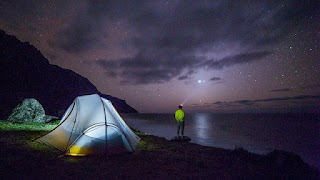
Marketers have left no stone unturned in drawing consumer attention through digital and traditional advertising. Our life, willingly or forcibly, is continuously interrupted by it. Be it billboards on roads, digital banners in malls, magazines, internet, newspaper, movies, airports, etc. - ads follow us wherever we go. Sometimes it seems that advertisements traps are set at all imaginable places.
But possibilities are infinite, and now humans are eyeing new space for promotions, and this new space is actually in space.
StartRocket, a Russian start-up, is all game for space advertising. It aims to display billboard advertisements in Low Earth Orbit of 400-500 kilometers and deliver 3-4 messages/images a day, through an array of tiny satellites, cubestats.
According to the website, this media has the potential of reaching 7 billion people. Apart from advertising, it also fits for:
- Entertainment, like displaying event-based messages or images during global events
- To notify people of important messages during the emergency
Disturbing the sky view:

Imagine you went out for night camping, sitting beside the campfire and gradually getting lost in this picturesque sky view of plentiful, bright and twinkling stars and wait, what? A fast-food company logo pop-up in the sky among those stars coaxing you to think about it.
Interrupting the astronomical research:
It can also disturb the astronomers in their cosmos studies.

Stinikov, the founder of StartRocket, clarified that his constellation will appear in the sky for only six minutes at a time, and can also be switched off in case it blocks something important. “I think scientists can use this time for peeing or having a coffee,” Skorupsky, another member of the StartRocket team, told Futurism. But can astronomers time-bound their research and pause it immediately when they see an ad emerging in the sky? Especially when they are in the middle of an important observation?

Space Junk:
Launching more projects in space will increase space traffic and accelerate the chances of space objects collision and destruction of important equipment. All this will also add to the problem of space debris.

“Once you start creating clouds of debris, the chances of additional accidents increase,” Jessica West, a program officer at Project Ploughshares and the managing editor of its Space Security Index, told Gizmodo. “And unlike a car accident on Earth, there isn’t a tow truck available to clean up the mess. Just think what driving would be like if we couldn’t clear messes off of the roads. Well, this where we are in space.”
But according to StartRocket, they won’t be adding to the space junk problem as their satellite will stay in space for only one year. “After that, we will bring them from orbit to the atmosphere where they will burn. All our CubeSats are remotely guided,” Sitnikov said.
For now, it seems that StartRocket, unfazed by all the wrath and debate, has sought answers to shut down the critics and determined to launch this ambitious project.
“Space has to be beautiful. With the best brands our sky will amaze us every night,” the website mentions.
Let’s see how businesses will receive this new media that demands a jaw-dropping investment of about $200,000 for every eight hours of advertising.
Is it wise to shell out this whopping amount for a logo or a brand message display? A display which not only is a very time-sensitive promotion, and but can also get blocked due to hazy and cloudy weather.
Or
Rather utilize it to achieve more marketing objectives other than branding and a better ROI through strategic planning?
So far, this is the marketer side of me who is awestruck to see how our restlessness to be more disruptive spawns innovation. However, the nature lover side of me is palpably nervous to see that a bountiful of these innovations have/had a toll on nature. Air, water, land, food - everything fundamental for our survival is polluted. And now the sky will be next.
StartRocket claims that their project will not corrupt the sky, violate the norms or add to any debris. Maybe what they claim is 100% correct and this initiative won’t prove detrimental to nature. But it all starts with a wee thing, with passing years, an increase in demand will attract more players, which means more space wreckage and more light pollution. This will eventually plague the space. The consequences might not be imminent. They may be felt after a few years, or a decade, or perhaps after 100 years. But, there are inevitable repercussions of interfering with nature.
While space advertising is bound by certain rules and national policies, but no one prohibits space advertising or covers all aspects of it. For example- Article 1 of the U.N. Outer Space Treaty stipulates the freedom for exploration and use of outer space for peaceful purposes. It also says that every nation should have access to use space accordingly, as long as they don’t cause harm to others’ activities.
Establishment of international law with clear do's and don'ts can address the space ad concerns. While protecting the interest of space advertisers, it should also rein in the commercialization of space, shield it from harmful intrusion and prevent it from turning into a littering ground.
StartRocket expects to complete the test launch in January 2021. Once launched, people might get accustomed to it, or maybe they'll turn ignorant towards it once their eyes overcome the surprise of space advertisement.
It is too early to judge. Let's wait and watch.
But one thing that none of us wants is a hodgepodge sky view.
Rather utilize it to achieve more marketing objectives other than branding and a better ROI through strategic planning?
So far, this is the marketer side of me who is awestruck to see how our restlessness to be more disruptive spawns innovation. However, the nature lover side of me is palpably nervous to see that a bountiful of these innovations have/had a toll on nature. Air, water, land, food - everything fundamental for our survival is polluted. And now the sky will be next.
StartRocket claims that their project will not corrupt the sky, violate the norms or add to any debris. Maybe what they claim is 100% correct and this initiative won’t prove detrimental to nature. But it all starts with a wee thing, with passing years, an increase in demand will attract more players, which means more space wreckage and more light pollution. This will eventually plague the space. The consequences might not be imminent. They may be felt after a few years, or a decade, or perhaps after 100 years. But, there are inevitable repercussions of interfering with nature.
While space advertising is bound by certain rules and national policies, but no one prohibits space advertising or covers all aspects of it. For example- Article 1 of the U.N. Outer Space Treaty stipulates the freedom for exploration and use of outer space for peaceful purposes. It also says that every nation should have access to use space accordingly, as long as they don’t cause harm to others’ activities.
Establishment of international law with clear do's and don'ts can address the space ad concerns. While protecting the interest of space advertisers, it should also rein in the commercialization of space, shield it from harmful intrusion and prevent it from turning into a littering ground.
StartRocket expects to complete the test launch in January 2021. Once launched, people might get accustomed to it, or maybe they'll turn ignorant towards it once their eyes overcome the surprise of space advertisement.
It is too early to judge. Let's wait and watch.
But one thing that none of us wants is a hodgepodge sky view.
Comments
Post a Comment